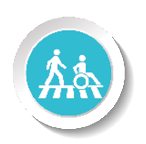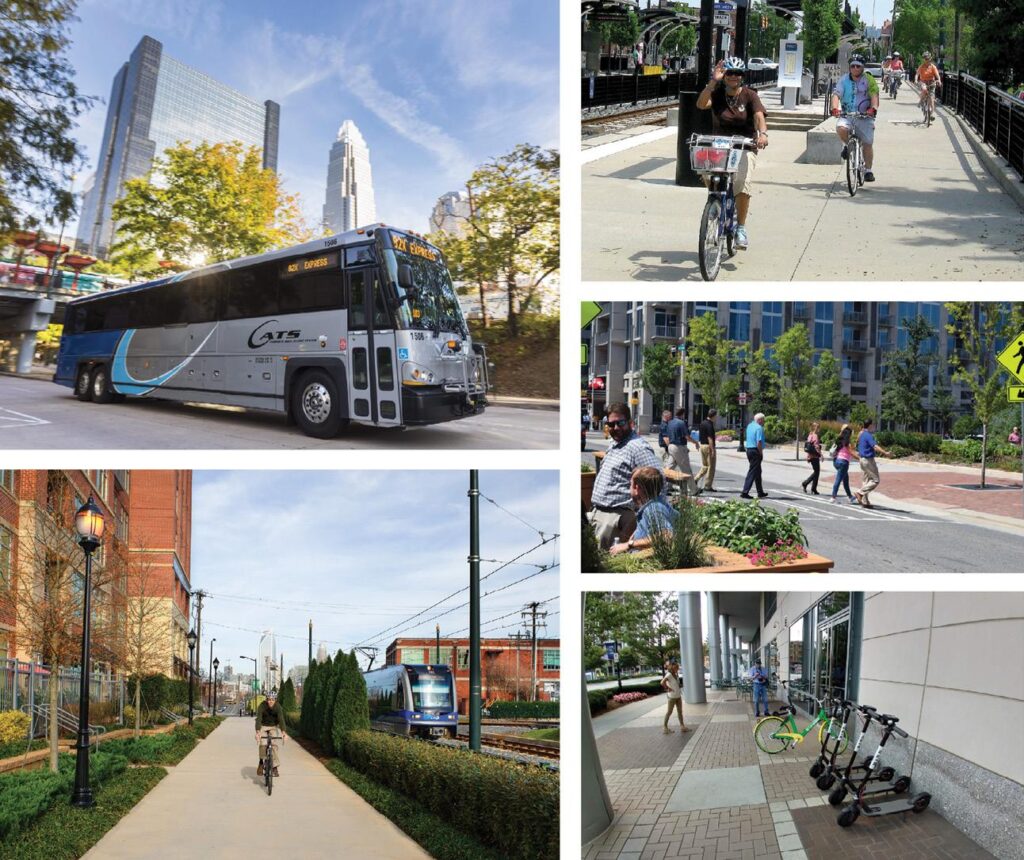Home / 03. Policy Framework / Goal 5: Safe and Equitable Mobility
Plan Policy
Table of contents
Goal 5: Safe and Equitable Mobility

Goal 5: Safe and Equitable Mobility

Charlotte will provide safe and equitable mobility options for all travelers regardless of age, income, ability, race, where they live, or how they choose to travel. An integrated system of transit and tree-shaded bikeways, sidewalks, shared-use paths, and streets will support a sustainable, connected, prosperous, and innovative network that connects all Charlotteans to each other, jobs, housing, amenities, goods, services, and the region.

Objectives
- Eliminate transportation-related fatalities and serious injuries to make our streets safe for everyone.
- Increase investment and access in our historically underinvested communities and modes of transportation to support equitable and affordable mobility options.
- Increase access to sustainable and zero carbon transportation modes and mobility options to support our Strategic Energy Action Plan.
- Increase the share of trips made without a car and broaden multimodal connectivity to expand the capacity of our transportation infrastructure.
- Prioritize transportation investments that promote economic vibrancy by managing congestion, connecting our workforce with opportunities, and advancing community priorities.
- Integrate and implement emerging transportation services, technologies, and programs that align with community goals.
Big Policy Ideas
- Set an aggressive mode shift goal that determines how the City 1) prioritizes investment in different modes of transportation, 2) allocates limited right-of-way space among different modes of transportation, 3) manages growth and travel demand, 4) sets new policies, and 5) supports equity and affordable transportation choices in all areas of the City.
Policies
- Prioritize the safety and comfort of travelers in all modes when planning and implementing mobility projects and focus safety investments on the “high injury network” – the 10% of Charlotte streets that account for 100% of serious injury and fatal crashes.
- Define transportation equity and develop quantitative equity metrics to guide the prioritization of programs and projects that ensure that people of all ages, abilities, and backgrounds have access to high-quality, affordable transportation choices. (cross-reference: Goal 1)
- Increase access to zero carbon transportation options for first- and last-mile trips and provide new and adapt existing transportation infrastructure to support a range of tree-shaded sustainable transportation choices. (cross-reference: Goal 6)
- Increase the mode share of walking, biking, transit and shared/micro mobility, setting and tracking goals for investment in infrastructure, strategies, and education programs. (cross-reference: Goal 4, Goal 6)
- Build and maintain our transportation infrastructure utilizing design, materials, and a program of regular maintenance that minimizes lifecycle costs and keeps our roadways and bridges in good repair.
- Expand street network connectivity, street tree canopy and protect right-of-way in growing and redeveloping areas to provide efficient access, route choices, and complete streets for all travel modes. (cross-reference: Goal 4)
- Ensure that public space and complete street design standards are incorporated into all street projects, recognizing that our streets should be designed as one of our greatest public space assets.
- Support the testing, piloting, and implementation of emerging mobility strategies, technologies, and creative uses of public right-of-way to evaluate low-cost and nimble mobility and streetscape investments.
- Monitor, measure and respond to shifting mobility preferences, behaviors and patterns.
- Leverage technology and partnerships to better manage congestion through advance planning, intelligent transportation systems, demand management, and shared public/private funding strategies.
- Improve neighborhood-serving mobility hubs (bus stops and ridesharing locations), especially in low-income neighborhoods, by providing amenities such as LED lighting, covered seating, trees, and aesthetic improvements, and co-locating with e-vehicle pickup locations.
- Include in the development regulations an integrated Traffic Impact Study (TIS) / Transportation Demand Management (TDM) program that requires development and redevelopment projects that meet an established threshold to evaluate and address the multi-modal transportation impacts of the development.
- Increase the number of pedestrian and bike routes that are shaded by trees for safety, health and aesthetic value.
- Participate in and support regional transportation efforts such as Connect Beyond, Beyond 77, and others.
Recommended Projects and Programs
- Vision Zero Action Plan: Continue implementation of the City’s adopted Vision Zero Action Plan to eliminate traffic deaths and serious injuries for all who share Charlotte streets by 2030.
- Pedestrian Program: Continue targeted investment in the pedestrian and sidewalk network to make strategic investments and fill network gaps. (cross-reference: Goal 1)
- Bicycle Program: Continue targeted investment in the bicycle network to make strategic investments and build a complete network.
- Transit Bus Priority Corridors: Implement transit priority and high-frequency service on key corridors.
- ADA Transition Plan: Implement the ADA Transition Plan by upgrading mobility infrastructure in compliance with the Americans with Disabilities Act (ADA) and Public Right of Way Accessibility Guidelines (PROWAG).
- Maintenance & Street Resurfacing: Resurface city streets on a regular (typically 12-to-15-year) cycle, maintain existing sidewalks, pavement markings, signage, and curb/gutter; take advantage of routine resurfacing to improve bicycling and walking facilities.
- Connectivity Program: Create new network connections for all modes, alleviate pressure on existing thoroughfares by providing new route choices, and stitch together Charlotte’s historically disconnected street grid. (cross-reference: Goal 4)
- Complete Streets Program: Build out new streets where right-of-way has been reserved by development and address needs identified by the regional CTP, and retrofit existing streets to include facilities for all modes, sidewalks, and street trees. (cross-reference: Goal 4)
- Traffic Control Devices & Intelligent Transportation Systems: Maintain, upgrade, and coordinate traffic signals to improve the efficiency and safety of Charlotte’s existing mobility network for all users.
- Bridge Maintenance: Inspect, maintain, repair, and replace City-maintained bridges.
- Street Lighting: Complete the conversion to LED lighting and install new street lights within our existing mobility network.
- Transportation Demand Management: Implement programs and projects that educate, encourage, and provide incentives for residents to choose travel modes other than single-occupant personal vehicles. (cross-reference: Goal 4, Goal 8)
- Partnership Opportunities: Preserve and support mobility opportunities by allocating dedicated funding for advanced planning and right-of-way acquisition for mobility projects, for public-private partnerships that allow the city to enter into cost-share arrangements with private stakeholders, and for upgrades to planned NCDOT infrastructure projects that are necessary to achieve the city’s mobility goals.
- Strategic Mobility Plan: Develop and regularly update a Strategic Mobility Plan, that establishes a comprehensive and prioritized strategy of mobility projects and programs to implement the shared goals and policies of the Comprehensive Plan.
- Crime Prevention Through Environmental Design (CPTED): Leverage investments in the mobility network to incorporate design considerations, features and elements that enhance personal and community safety (e.g., limiting obstructions, increasing lighting, etc.).

Image source:
https://seattlegood.org/listings/commute-seattle/
https://www.seattlebusinessmag.com/green/tableau-tool-tackles-seattles-terrible-traffic
Seattle’s Commute Trip Reduction (CTR) program plays a crucial role in the City’s effort to reduce congestion and provide mobility choices. The CTR program is a key transportation demand management effort toward mitigating the impacts of population and employment growth while facilitating a thriving business environment, diverse travel choices, and a reduction in transportation emissions. The 2019-2023 CTR Strategic Plan establishes the vision for the next era of Seattle’s program, building upon recent program innovations to position Seattle and its employers for ongoing success. The Plan sets performance targets and identifies priorities for the next five years. It outlines a package of potential solutions to continue to deliver high-quality programming and meet the challenges Seattle’s transportation network faces. It also establishes updated Drive Alone Rate (DAR) targets to support Seattle’s overall mode split goals. Each area of the city is assigned a target and the achievement of all network targets means that the city as a whole reaches its DAR target of 25% by 2035, established by the Seattle 2035 Comprehensive Plan.
Image source: https://www.commuterpage.com/ways-to-get-around/local-bus-systems/

Residents, employees and visitors of Arlington, Virginia are benefiting from the enhanced Transportation Demand Management (TDM) programs the City has executed. With a goal to reduce single-occupancy vehicles (SOV) trips throughout the community, the City is offering more and better mobility choices, which encourage people to use forms of transportation other than driving alone. TDM programs include increased parking prices, discounted transit passes, high-quality bicycle parking and associated facilities (e.g. showers and changing rooms), and real-time transit information. The City has worked with developers and businesses to support infrastructure, amenities, polices and programs to maximize the effectiveness of TDM strategies.
